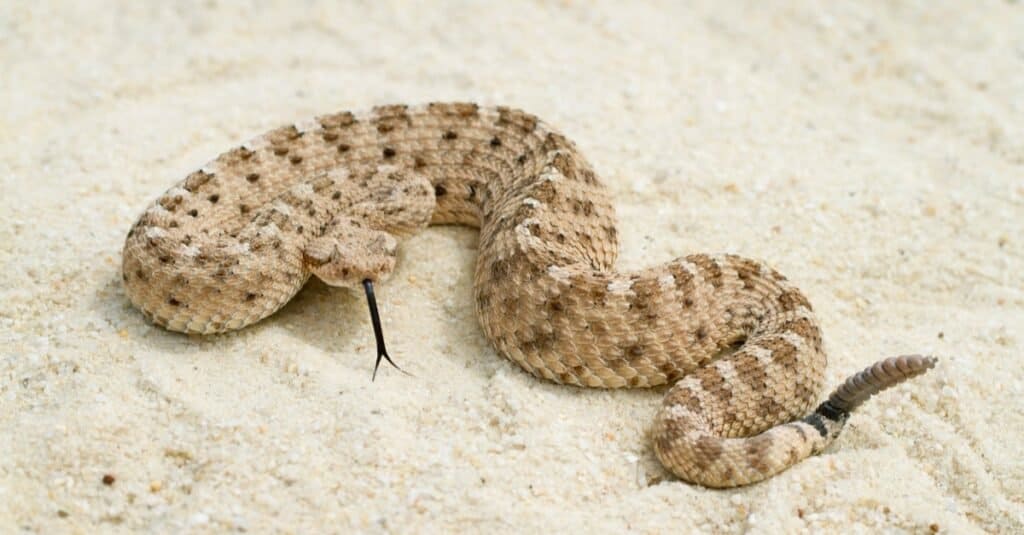Sidewinder
.jumbotron {
background-image: url(“https://a-z-animals.com/media/2021/05/Amazing-Desert-Animals_-Sidewinder-400×300.jpg”);
}
}
@media only screen and (min-width: 641px) and (max-width: 920px) {
.jumbotron {
background-image: url(“https://a-z-animals.com/media/2021/05/Amazing-Desert-Animals_-Sidewinder-470×370.jpg”);
}
}
@media only screen and (min-width: 921px) {
.jumbotron {
background-image: url(“https://a-z-animals.com/media/2021/05/Amazing-Desert-Animals_-Sidewinder.jpg”);
}
}
Sidewinder
Crotalus cerastes
Sidewinder Scientific Classification
- Kingdom
- Animalia
- Phylum
- Chordata
- Class
- Reptilia
- Order
- Squamata
- Family
- Viperidae
- Genus
- Crotalus
- Scientific Name
- Crotalus cerastes
Read our Complete Guide to Classification of Animals.
Sidewinder Conservation Status
Sidewinder Facts
- Prey
- Mice, lizards, birds
- Name Of Young
- Neonates or snakelets
- Estimated Population Size
- over 100,000 adults
- Most Distinctive Feature
- The hornlike structures on this snake’s head are why it’s sometimes called a horned rattlesnake.
- Distinctive Feature
- Its triangular shaped, flat head
- Other Name(s)
- Horned rattlesnake
- Litter Size
- 5-18 live young
- Diet
- Omnivore
- Common Name
- Sidewinder
- Number Of Species
- 3
Sidewinder Physical Characteristics
- Skin Type
- Scales
- Venomous
- Yes
- Aggression
- Low
This post may contain affiliate links to our partners like Chewy, Amazon, and others. Purchasing through these helps us further the A-Z Animals mission to educate about the world’s species..

Discover alligator-eating snakes, spiders larger than your phone, and 1000 more incredible animals in our daily FREE email.
.photo-gallery {
–margin: 0px auto 0px;
–padding: 0px 0px 0px 0px;
}
.gallery-link {
background-image: url(“https://a-z-animals.com/media/2022/02/shutterstock_1718369104-1024×535.jpg”);
background-repeat: no-repeat;
background-size: cover;
background-position: center;
height: 500px;
justify-content: center;
text-align: center;
align-items: center;
display: flex;
border: 2px solid #000;
}
.gallery-link img {
height: 50%;
}
@media only screen and (max-width: 768px) {
.gallery-link {
height: 300px !important;
}
}
View all of the Sidewinder images!
Sidewinders can reach a traveling speed of 18mph.
Sidewinder rattlesnakes are relatively small at 18 to 32 inches long. They live in a desert habitat. These snakes are named for their unique movement. They have powerful venom and eat rodents, birds, and lizards.
3 Sidewinder Amazing Facts
- The hornlike structures on this snake’s head are why it’s sometimes called a horned rattlesnake
- It gives live birth to its young in a burrow
- It sometimes uses its tail as a lure to attract prey such as lizards and birds
Where to Find a Sidewinder
Sidewinders are North American snakes living in the United States and Mexico. They live in a desert habitat in the southeastern part of California, southwestern Utah, southern Nevada, and the western portion of Arizona. In addition, they are found in western Sonora and Baja California in Mexico.
button.pulse {
transform: scale(1); animation: pulse 2s infinite;
box-shadow: 0 0 0 0 rgba(11, 247, 25, 1);
}
@keyframes pulse {
0% { transform: scale(0.90); box-shadow: 0 0 0 0 rgba(11, 247, 25, 0.5); }
60% { transform: scale(1); box-shadow: 0 0 0 15px rgba(11, 247, 25, 0); }
100% { transform: scale(0.90); box-shadow: 0 0 0 0 rgba(11, 247, 25, 0); }
}
This snake is active during the day throughout the cooler weather months. Alternatively, it’s nocturnal during the warm weather season. Depending on their home region, some sidewinders go into brumation for the cold weather season.
The mating season of this pit viper starts in April and extends into July. This is when these snakes are especially active. One of the most intriguing facts about this reptile is male sidewinders sometimes travel for hours to find a female.
Types of Sidewinders
The sidewinder belongs to the Viperidae family. It has two subspecies of sidewinder that are very similar in appearance. The main factor that differentiates the three total subspecies is location.
The two other subspecies are:
- Sonoran Desert Sidewinder (Crotalus cerastes cercobombus)-This snake makes its home in Sonora, Mexico, and southern Arizona. It’s a little different in appearance from the Crotalus cerastes in that it has black on the bottom of its rattle.
- Colorado Desert Sidewinder (Crotalus cerastes laterorepens)-The range of this pit viper extends from the southeastern part of Mexico into California. It also lives in the Colorado River valley.
Sidewinder Scientific Name
Crotalus cerastes is the scientific name of the sidewinder rattlesnake. It’s also called the horned rattlesnake. Its Latin name cerastes translates to the word horn.
It’s in the Viperidae family and Reptilia class.
Sidewinder Population and Conservation Status
The IUCN Red List of Threatened Species states this rattlesnake has a stable population of over 100,000 adults. It’s reported as Least Concern.
How to Identify Sidewinders: Appearance and Description
When you think about a sidewinder you may envision a very large snake moving sideways through the desert sand. But this snake is surprisingly small at 18 to 32 inches long.
It has a triangular-shaped, a flat head, and a hornlike structure above each of its eyes.
This snake is a pit viper, so it has a pit or hole on each side of its snout. The sidewinder uses these pits to detect the location of its prey. These pits are sensitive to the infrared radiation given off by rodents, birds, and other animals.
The scales of a sidewinder have a rough, sturdy texture. This is an adaptation helping the snake to move through the hot sand of its desert habitat. The scales of this snake are light in color from tan to pale gray. It has a pattern of darker brown or gray spots on its back. There is a dark stripe near each eye of this pit viper. Its neutral coloration is another adaptation that helps it survive in the desert. They blend into their habitat very easily!
It has a line of segmented rattles on its tail. Like other types of rattlesnakes, the sidewinder shakes its rattled tail as a warning to threats to move away. One of the most interesting facts about this snake’s rattles is they are hollow. It’s the segments of the rattle hitting one another that creates the warning sound.
How to identify a sidewinder:
- Tan or light gray base color
- Dark brown or gray splotches on its back
- Hornlike structure above each eye
- A triangular, flat head
- A dark brown or black stripe next to each eye

Mark_Kostich/Shutterstock.com
Sidewinder Venom: How Dangerous Are They?
Sidewinders can deliver venom through their bite. But they are shy snakes and are more likely to give a warning by rattling their tail or trying to escape with great speed.
If you’re bitten by a sidewinder, the first thing to do is call an ambulance. This snake’s venom causes serious symptoms if the bite is not treated.
While waiting for emergency medical services, move to a shaded area and stay as still as possible. If you have jewelry or a watch on the wounded limb, take it off in case there’s extreme swelling. Wash the wound gently with soap and water without dipping it under water. Put a bandage over the injury.
If possible, take note of the time of the bite so you can tell medical professionals how long the venom has been in your system.
Sidewinder Behavior and Humans
Sidewinders are shy snakes. So, if it bites it usually happens accidentally. Someone may step on the snake without seeing it or reach into an area where the snake cannot escape. The snake bites because it’s frightened.
View all 186 animals that start with S
Sidewinder FAQs (Frequently Asked Questions)
Are sidewinders venomous?
Yes, one of the main facts to remember is they have venom.
How do sidewinders hunt?
These snakes are known as ambush hunters. This means the snake buries itself in the sand and waits for a bird, lizard, or rodent to enter the area. When it does, the snake appears and gives its prey a bite to inject its venom. The prey may move away, but it slows down as the venom takes effect. Once the prey is dead, the pit viper swallows it.
As a note, these pit vipers are able to find areas with rodents, birds, and lizards. The pits located in its snout can detect infrared radiation given off by prey.
Are sidewinders aggressive?
No, though the horns above their eyes make this snake look threatening, it has a shy nature.
Where do sidewinders live?
These are North American snakes living in the southwestern United States and northern Mexico.
What do sidewinders eat?
Sidewinder rattlesnakes eat rodents, birds, and lizards. Their diet includes banded geckos, whiptail lizards, fringe-toed lizards, kangaroo rats, gophers, and more.
Is a sidewinder poisonous?
Yes, these snakes are poisonous.
How potent is sidewinder venom?
Their venom is potent enough to immobilize small prey. Furthermore, its venom can cause serious symptoms to a human who is bitten including trouble breathing, low blood pressure, blurred vision, and more.
How do sidewinders survive in the desert?
One adaptation helping sidewinders survive in their desert habitat is rough scales. These scales allow them to move in an S-motion across the hot sand without burning themselves. In fact, they can travel at a speed of up to 18mph!
Another adaptation is the neutral colors of this snake allow it to blend into its desert habitat. This makes it easier for the snake to capture prey.
A particularly interesting adaptation of a sidewinder relates to its eyes. The hornlike structure above each eye serves to protect its eyes from the sunlight and blowing sand. These horns are unique and aren’t found on other rattlesnakes such as the western diamondback rattlesnake in Texas.
The sidewinding movement of this snake is not just entertaining to watch. It also serves a purpose. As the sands of the desert blow they shift around. This shifting ground would be difficult for a snake to navigate with a traditional slithering motion like that of the timber rattlesnake in Texas. But this rattlesnake moves along in a sideways motion helping it to travel efficiently in its ever-changing habitat. Plus, only a small part of its body hits the ground as it propels itself which further protects its body from the hot sand.
What is the difference between a rattlesnake and sidewinder?
A sidewinder is a type of rattlesnake. Specifically, it’s a North American rattlesnake that lives in a desert habitat.
One difference is while many rattlesnakes move in a traditional forward motion like the timber rattlesnake in Texas, a sidewinder moves in a sideways locomotion.
How do sidewinders move?
These snakes propel themselves sideways across the sand by pushing one area of their body into ground with each movement. This helps them to avoid sinking into the hot sand.
Sources
- Buffalo Zoo, Available here: https://buffalozoo.org/animal/mojave-desert-sidewinder/
- EOL, Available here: https://eol.org/pages/815843
- WSED, Available here: https://wsed.org/viperid-spotlight-all-about-sidewinders-crotalus-cerastes/
- Reptile Database, Available here: http://reptile-database.reptarium.cz/species?genus=Crotalus&species=cerastes&search_param=%28%28search%3D%27sidewinder%27%29%29
- IUCN Red List, Available here: https://www.iucnredlist.org/species/64315/12764960
- Active Wild, Available here: https://www.activewild.com/sidewinder/
- Wikipedia, Available here: https://en.wikipedia.org/wiki/Crotalus_cerastes
















